Equity & Diversity Annual Report – 2004 Section 3: Workplace Diversity Plan
Since the RBA formally announced its commitment to equal employment opportunity in May 1984, six plans have been implemented and reported on to progressively achieve the objectives of the equity and diversity program.
Workplace Diversity Plan 2001–2005
The development of the sixth plan, Workplace Diversity Plan 2001–2005, involved assessing the RBA's policies and performance against the requirements of the Equal Employment Opportunity (Commonwealth Authorities) Act 1987. In addition, the principles endorsed in the Public Service Act 1999, the Equal Opportunity for Women in the Workplace Act 1999 and the Human Rights & Equal Opportunity Commission's Best Practice Guidelines were also explored.
The plan recognises the diversity of staff and seeks to accommodate this within broader policies relating to recruitment and selection, staff training and development and conditions of employment.
The five key areas identified in the plan are:
- Gender
- Work Life Balance
- Indigenous Australians
- Race-Ethnicity
- People with Disabilities
A summary of the diversity plan initiatives related to these areas is provided at Appendix 4.2.
As part of the first stage of the plan, a comprehensive workplace profile covering designated groups, age and gender, qualifications, and management composition was prepared. The profile provides a basis for analysing the effectiveness of the plan and identifying further initiatives. While a number of workplace profiles are provided in this section, additional statistics are provided at Appendix 4.4.
The plan is due for review in 2005.
3.1 Workplace Profiles
Diversity profile
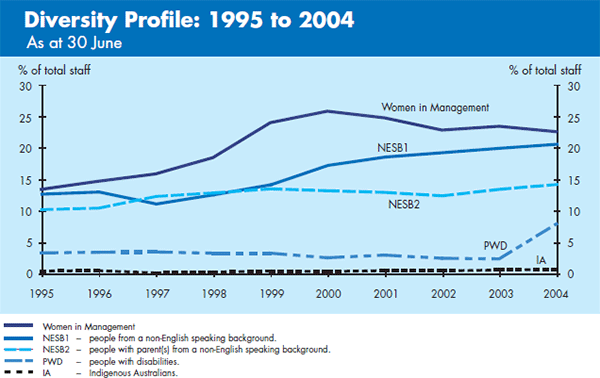
The percentage of Indigenous Australians at the RBA has remained stable for the past 10 years. This is in contrast to the percentage of women in management and staff from a non-English speaking background (NESB1) or whose parents are from a non-English speaking background (NESB2), which have increased over the same period. The percentage of people with disabilities appears to have increased substantially in the last reporting period. The above areas are analysed in detail in this section of the report.
Age
The median age of RBA staff is now 37 years, compared with 36 in 2003. Forty-five per cent of staff are aged less than 35 years, down 1% from last year. Over the next ten years, 28% of RBA staff will be eligible for retirement. Comparatively, Australian Public Service (APS) data from last year reports the median age of the APS workforce at 41 years and that 37% of the APS workforce is aged 45 years and over. Further analysis of the ageing population will be undertaken in the next reporting period.
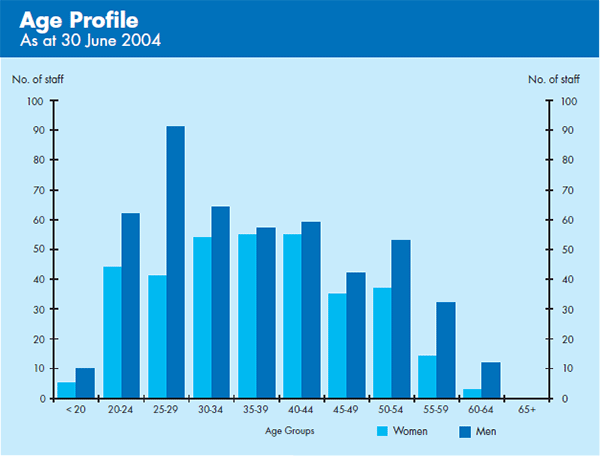
Tenure
There has been little change in the tenure statistics over the last few years. The average tenure remains at 11 years for this reporting period. Fifty-five per cent of staff have less than 10 years service as compared to 50% in 2003. Twenty-one per cent have more than 20 years service, up 1% from 2003. Fifty-seven percent of staff have more than five years service. The retention rate for graduates is lower than for other staff but remains acceptable. Further analysis on graduate retention will be undertaken in the next reporting period.
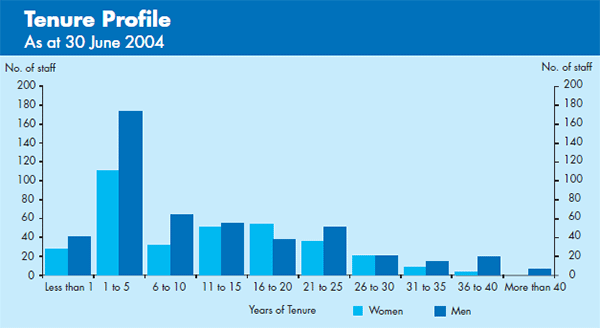
3.2 Gender
Women as a percentage of the workforce
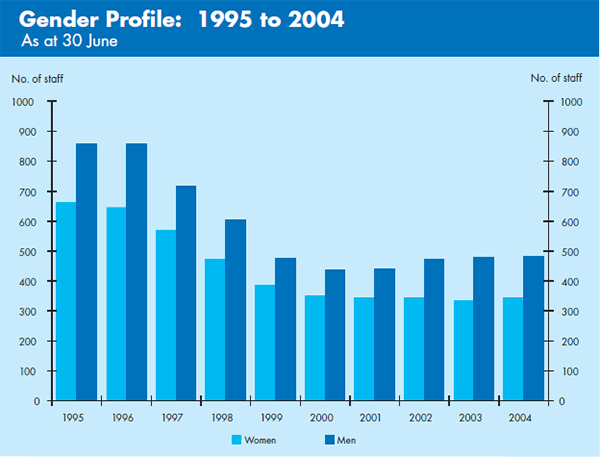
Over the past six years staff numbers have remained relatively stable. As at 30 June 2004, women represented 42% of total staff. This percentage has varied between 41% and 45% over the past 10 years.
Occupational Groups
Gender representation in the various occupational groups continues to be monitored, as well as changes in occupational structure over time. The two main occupational groups are clerical and professional.
The percentage of women in clerical positions continues to decline, with 43% of women employed in clerical roles in 2004 as compared to 47% in 2003. Clerical positions made up 26% of all positions compared to 28% in 2003 and 41% in 1999. Sixty-seven per cent of these positions were held by women compared to 68% last year. Forty per cent of professional positions are held by women. Six years ago representation was 25%.
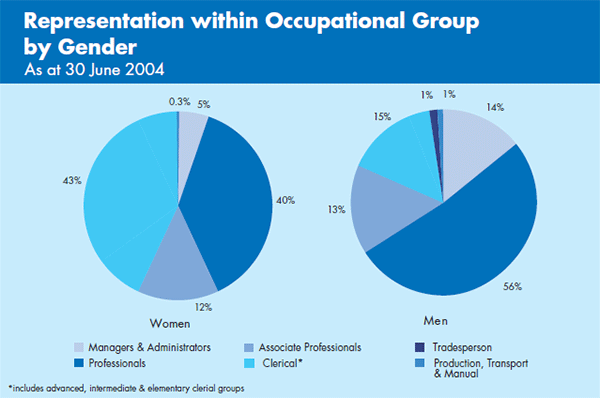
Women in Management
Five per cent of women at the RBA are employed in management positions as compared to 14% of men. Twenty-three per cent of all RBA management positions are held by women. This is substantially higher than in 1995 when representation was 13%. In December 2003, the staff magazine Currency featured an article on four senior women who had recently been promoted or nominated to act at a higher level. This is the highest number of women the RBA has seen at senior levels.
Senior women at the RBA as featured in the December 2003 edition of Currency




Transfers, Rotations and Secondments
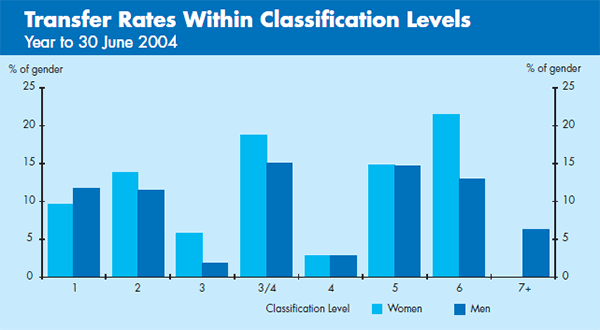
Further staff development is achieved through transfers and rotations within the RBA, including to overseas and regional offices. Transfers are permanent appointments to a position. The number of transfers recorded for 2003/04 was 63 compared to 71 last year. The percentage of women transferring within the reporting period was 9% up from 7% last year. The transfer rate for men was down, with 9% of men being formally transferred compared to 13% last year.
Rotations are temporary movements of staff. The number of rotations decreased from 55 last year to 51 in 2003/04. With the exception of 2002, the number of rotations has been steadily declining for the past six years. While women have generally lagged behind men in the transfer rate, the percentage of women rotating has generally been higher than that of men. In 2004 however, the percentage of women rotating was equal to that of men at 7%.
Secondments are also available to other relevant institutions. Over the past year, staff have worked at the Bank for International Settlements, the Bank of England, the Australian Treasury, the Australian Taxation Office, and Australian Prudential Regulation Authority.
Graduate Recruitment
Graduate Development Program
In the 2004 recruitment drive 393 applications were received for the Graduate Development Program. This was a 44% decrease on the number of applications received the previous year mostly due to the success of a more targeted marketing campaign attracting higher numbers of quality applicants. The ratio of women to men applying increased marginally compared with the last reporting period but continues to reflect the gender ratio of honours level enrolments in economics at Australian universities. The ratio of women to men called to interview was equal to the previous reporting period at 50:50. The ratio of women to men offered graduate positions in 2004 was very similar to the previous reporting period – 64% of women and 84% of men who were interviewed were offered positions.
| Year | Women | Men | Total | Ratio |
|---|---|---|---|---|
| 2004 | 8 | 21 | 29 | 38:62 |
| 2003 | 8 | 26 | 34 | 24:76 |
| 2002* | 14 | 25 | 39 | 36:64 |
| 2001 | 7 | 26 | 33 | 21:79 |
| 2000 | 14 | 20 | 34 | 41:59 |
| * The 2002 figures include 4 graduates that did not participate in the Graduate Development Program (2 male and 2 female) | ||||
Cadetship Award
In the 2003/04 recruitment drive 123 applications were received for the Cadetship Award. Similar numbers of applications have been received over the past three years. The ratio of women to men who apply for the cadetship has remained fairly constant at approximately 35:65 for the last five years. As with graduate applications this ratio continues to reflect the gender ratio of honours level enrolments in economics at Australian universities.
The interview process saw 31% of female applicants and 25% of male applicants called to interview. The ratio of women to men offered cadetships in 2004 was significantly higher in favour of women than in previous years – 60% of women and 37% of men who were interviewed were offered positions. Fifty per cent of the 2003/04 cadets were women.
| Year | Women | Men | Total | Ratio |
|---|---|---|---|---|
| 2004 | 9 | 9 | 18 | 50:50 |
| 2003 | 7 | 10 | 17 | 41:59 |
| 2002 | 3 | 16 | 19 | 15:85 |
| 2001 | 8 | 10 | 18 | 44:56 |
| 2000 | 6 | 9 | 15 | 40:60 |
Individual Contracts
In recent years individual employment contracts, which provide a degree of flexibility in remuneration, have been offered to most staff following a systematic market benchmarking exercise. The move to individual contracts is voluntary, except for new graduate recruits or staff promoted to Level 6 and above. Staff who decide against the offer of contract employment retain existing conditions of work.
| Occupational Group | Women (%) | Men (%) | Total (%) |
|---|---|---|---|
| Managers | 83 | 96 | 93 |
| Professionals | 72 | 79 | 77 |
| Associate Professionals | 33 | 67 | 53 |
| Clerical* | 18 | 26 | 21 |
| Total Staff on Individual Contracts | 45 | 70 | 60 |
| * Includes advanced, intermediate, and elementary clerical staff. | |||
There has been a steady increase in staff on individual employment contracts over the past few years. As at 30 June 2004, 60% of staff were on individual employment contracts, compared to 57% in 2003 and 53% in 2002. Eighty per cent of staff in managerial and professional positions are on contracts.
Interestingly, only 45% of women are on individual contracts as compared to 70% of men. This is likely to be due to the higher representation of women in clerical positions. Further analysis will be undertaken in the next reporting period.
Pay Equity
A pay equity analysis is conducted every two years; the next one is due in the 2004/05 reporting period. In 2002/03 women earned on average 83% of what men earned. This is consistent with ABS data, which showed that nationally, on average, women's earnings were 84% of men's earnings. Occupational segregation – women being highly represented in clerical positions relative to management positions – and unequal workforce participation are likely to be the major contributing factors.
3.3 Work Life Balance
Carer's Leave
Carer's Leave can be taken either on a half or full day basis. In 2003/04 it was used by 352 staff (43%); with each of those staff taking an average of 2¾ days leave. This is similar to previous years. There was a notable increase in the number of men taking Carer's Leave; of the 352 staff who took the leave, 54% were men, up 4% from 2003. As a percentage of gender, 47% of women used Carer's Leave and 39% of men.
Part-Time Work
During the year, 61 staff worked part-time (56 female, five male) compared to 49 (48 female, one male) last year. The figures reflect mostly women on temporary part-time work arrangements and do not include staff on fixed term contracts or university students engaged in part-time work.
Parental Leave
Women are entitled to 14 weeks' paid maternity leave and men to one week's paternity leave. The chart below provides a breakdown based on gender for staff commencing paid parental leave.
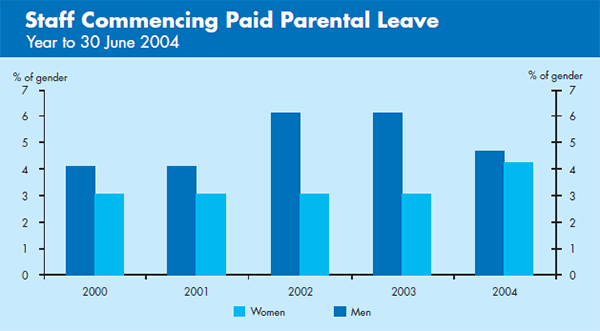
During 2003/04 a total of 36 staff commenced paid parental leave (16 women and 20 men). This compares to last year where 33 staff commenced paid parental leave (18 women and 15 men).
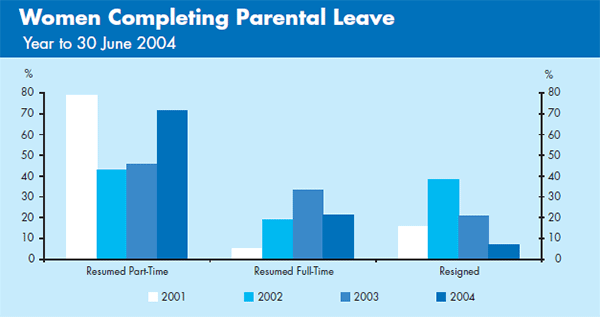
The RBA achieved a 93% return rate from parental leave over the year. Of the 14 women completing parental leave, only one woman resigned. This compares to 79% in 2003. The adjusted return rate for 2003 was 92% when taking into account the closure of Adelaide branch which resulted in the retrenchment of three women returning from parental leave.
There was also an increase in the percentage of women electing to return to work part-time following parental leave. Of the 13 women who returned to work in 2003/04, 10 elected to work part-time (77%). This compares to 19 women returning in 2003, with 11 electing to work part-time (58%)
As part of the 2003–2004 Enterprise Bargaining Agreement, the RBA and the main workplace union have agreed to review the RBA's parental leave arrangements in light of any decision by the Australian Industrial Relations Commission on the parental leave test case currently before it.
Work and Family Intranet Site
The Work and Family site on the Personnel Department intranet was reviewed and streamlined in March 2004. Information is now provided in a more user-friendly, accessible format. Additional links to external providers were also added to the site.
Fitness Facility
The RBA encourages a healthy lifestyle. In addition to supporting sporting events, the RBA operates a fitness facility at Head Office. The facility is available for use by staff at lunchtime and out of work hours. Staff desiring to use the facility must first attend a training session in the safe use of the equipment. Approximately 500 staff have received this training. During the year additional gymnasium equipment was purchased and pilates and yoga classes were offered from October 2003 onwards. At year end around 85 staff were attending these classes each week.
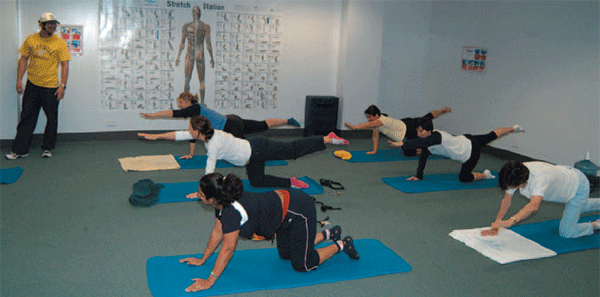
3.4 Indigenous Australians
Indigenous Australians continue to account for a very small proportion of staff, 0.7% in 2004, although this is up 0.1% from 2003. Steps taken to encourage more Indigenous Australians to apply for employment with the RBA include designating one Business Administration Traineeship position for an Indigenous Australian. This position was again successfully filled for 2004. The 2003 Indigenous Australian trainee was employed by the RBA at the end of her traineeship.
National Indigenous Cadetship Project
The feasibility of utilising the Australian Government's National Indigenous Cadetship Project is also currently being investigated as an additional way of targeting Indigenous Australians for employment opportunities within the RBA.
NAIDOC Week
As one way of recognising Indigenous culture, the RBA took the opportunity to highlight and promote to staff NAIDOC (National and Aboriginal Islander Day Observance Committee) week in July 2003.
3.5 Race-ethnicity
Representation at RBA
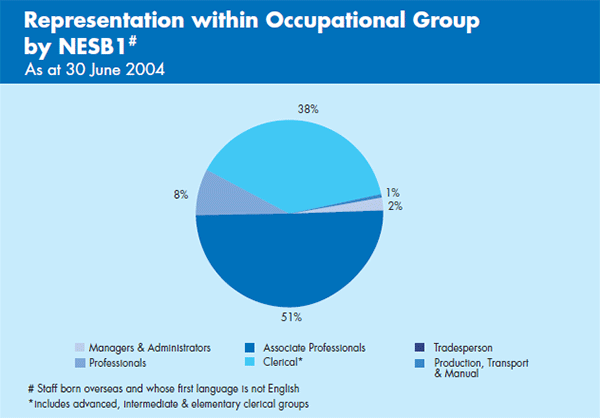
The percentage of staff who identified themselves as NESB1 (staff who are born overseas and whose first language is not English) has increased 1% from last year (21%). These employees are heavily represented in the RBA's information technology, accounting and audit departments and share a common characteristic of being more highly qualified than other staff in these areas. Consistent with the qualification levels found amongst the NESB1, an analysis of occupational groupings shows that 48% are represented in professional occupations. The graph also shows that 2% of this group are employed in management positions.
Business Writing Training
The RBA again offered staff Technical Business Writing and Today's Business Writing training to assist with career progression. The objective of the two-day Technical Business Writing course is to tailor training in the area of written communication to reflect the more technical nature of the documents produced by the information technology, accounting and audit departments. The training acknowledges the varying communication styles used by different cultures. In 2003/04, 18 staff who identified themselves as NESB1 attended a business writing course; five have since undertaken individual coaching as a follow up to the training. Business Writing Coaching was introduced for the first time in 2004.
Harmony Day
For the week leading up to 21 March 2004, the RBA supported and promoted Harmony Day. Staff were provided with information about the meaning of the day via the intranet, the staff magazine Currency, and staff newsletters. Harmony Day ribbons were also available for staff to wear and the staff café provided an array of international dishes throughout the week.
Cultural Awareness Workshop
Participants of the 2004 Central Banking Management Program undertook cultural awareness training in May 2004. Further workshops are currently being scheduled for the next reporting period including a two-day Intercultural Interviewing Workshop for the Staff Resourcing team.

3.6 People with Disabilities
Representation at RBA
The figures for the representation of staff with disabilities have increased substantially from 2% last year to 8% in 2004. This can be explained by the revised equity and diversity form that was sent to all staff in April 2004. The form assisted in capturing staff who have acquired a disability since commencing at the RBA. This figure is still likely to be conservative as the definition of disability is subjective and fear of embarrassment may reduce the number willing to identify their disability.
Disability Action Plan: Access & Equity 2003–2005
The Disability Discrimination Act 1992 (DDA) makes discrimination against people with disabilities, and their associates, unlawful in the administration of Commonwealth laws and programs, as well as in a range of other areas.
As part of the DDA, a ten-year plan, known as the Commonwealth Disability Strategy, was developed to remove barriers in Commonwealth policies, programs and services for people with a disability. All Commonwealth agencies were encouraged to develop a Disability Action Plan under the Act.
In December 2003, the RBA launched its second action plan under the Commonwealth Disability Strategy. The objective of Disability Action Plan: Access & Equity 2003–2005 (‘the Plan’) is to enable equal access to the RBA's policies, programs, facilities and services. It recognises that people with a disability, whether temporary or permanent, have a right to enjoy the same services and employment as all other members of our community.
While the first plan, Disability Action Plan 1998, focussed primarily on direct interaction with the public, the revised version takes a common approach to accountability arrangements for staff and for the public who use the RBA's services. The Plan also seeks to address common standards, for example, W3C internet guidelines to be considered for intranet development. The Plan retains the requirement to address the RBA's public interface arrangements via departments such as Note Issue, Banking, Facilities Management, Information and Systems & Technology, but also broadens its scope to address internal arrangements, with the consideration of staff with disabilities.
Monitoring & Evaluation
A consultative group of staff with known disabilities, together with a sub-committee of Diversity Contact Managers meet on a quarterly basis to monitor the progress of the implementation of the Plan. This group also acts as a forum for any new initiatives or issues in the workplace as they arise.
Responsibility for the annual monitoring and evaluation of progress against individual initiatives rests with the respective Heads of Department. Overall responsibility for the effective implementation of the Plan lies with Personnel Department and is part of the RBA's corporate responsibilities.
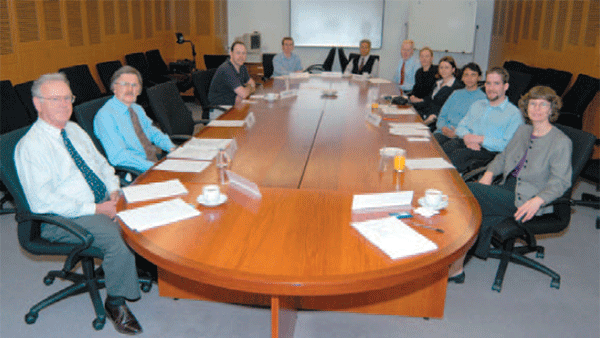
Following the Office of Disability review of the Commonwealth Disability Strategy in 2004, and in line with the review of the RBA's Workplace Diversity Plan 2001–2005, the Plan will be reviewed in 2005.
Progress Reporting
The RBA's Equity & Diversity Policy Committee determined that the Plan would be incorporated into the RBA's Workplace Diversity Plan 2001–2005. Consequently the Equity & Diversity Annual Report is the platform for reporting on the progress of specific Plan initiatives. Highlights on the progress of several Plan initiatives are provided in this section of the report. Specific progress on each of the Plan initiatives is listed at Appendix 4.3.
Adjustments in the workplace
Advice on making adjustments in the workplace to accommodate the needs of staff with disabilities is available to departments. This is provided through the RBA's Consultant, OH&S.
An initiative introduced in 2003/04 has involved the Consultant, OH&S formally reviewing the environment of all staff with known disabilities on a six monthly basis, or on promotion or transfer. The aim is to identify any areas requiring assistance or improvements. As a result of the OHN surveys conducted in November 2003 and May 2004, a number of improvements have been made to the workplace. These include the installation of Induction Loops in the Head Office training rooms and permanent Braille markings in passenger lifts.
The Consultant, OH&S position is job-shared by
Belinda Stapleton and Karen Thomas


As part of the personal details update, all staff were provided with the opportunity to advise if they require any assistive technologies or adjustment in their workplace.
Consultation
The RBA consults with disability groups, both internally and externally. Externally, representatives from The Spastic Centre, NILS (A Joint Venture between the Royal Victorian Institute for the Blind, The Royal Blind Society of NSW, and Vision Australia Foundation), Beyond Blue, Self Help for Hard of Hearing People, and Guide Dogs NSW have attended meetings at the RBA. Internally, the Disability Action Plan Consultative Group, and the Systems Accessibility Technical Group have provided input into various policies, procedures and applications.
Awareness
The RBA Disability Awareness Workshop continues to be held annually for staff and managers to raise the level of understanding and awareness in relation to identifying barriers for people with disabilities. The workshop also introduces strategies for overcoming these barriers. A total of 102 staff have attended these workshops since they were first introduced in 1999.
Specific disability workshops are currently being scheduled for the next reporting period. Two half-day workshops, Beyond Blue and Understanding Psychological Problems in the Work Setting, are to be piloted. Staff from the Disability Action Plan Consultative Group as well as participants from the 2004 Central Banking Management Program will be invited to the pilots. The sessions will provide information on identifying and managing staff suffering from depression or anxiety.
Brochure: Supporting Staff with Disabilities
The Disability Action Plan Consultative Group worked together with Personnel Department to create a disability awareness brochure, Supporting Staff with Disabilities. The brochure was sent to all staff in February 2004 and is available on the intranet. All new starters receive a copy as part of their induction.
International Day of People with a DisAbility
On 3 December 2003, the RBA celebrated International Day of People with a DisAbility. Information about the meaning of the day was provided via the intranet and the staff magazine Currency. Displays and information leaflets were also placed in the staff café.
Staff Magazine Feature Articles
In May 2003, two staff – Timothy Edwards and David Herridge – featured in the staff magazine Currency. Both staff members are profoundly deaf and have had cochlear implants. A film crew attended the RBA offices as part of a documentary on Timothy's implant. David also featured in the March edition in an article on the HR/Payroll system upgrade, having run training sessions for system users. Both David and Timothy attend the Disability Action Plan Consultative Group meetings.

Access
Within Head Office, significant progress was made towards the completion of the Museum of Australian Currency Notes. In conjunction with this project, access for people with disabilities is being upgraded to both the general banking chamber and the museum.
Accessibility
Protocol
An accessibility protocol for software, hardware and applications was implemented in 2004. The intention is for the protocol to become a basic reference document that can be extended over time where necessary. It includes a checklist for web based applications using guidelines developed from World Wide Web Consortium (W3C), and non-web applications.
An inventory of the RBA's systems was undertaken in January 2004. Systems are ranked by priority level, and against the relevant accessibility standard. Accessibility improvements have initially been directed to the higher profile systems, e.g. RBA website.
For new applications or for applications requiring modification, the systems project initiation process now incorporates a step for the project manager to make an initial statement on how they will be addressing accessibility for a project. A report on accessibility is also required at the end of the project.
Accessibility Workshop
A workshop for Application Developers and Project Managers from Systems and Technology Department, designed to raise their awareness of application tools available to improve systems' accessibility, was piloted in December 2003. A second round of workshops was held in March 2004. Most Developers and Project Managers have now attended the workshop. Further workshops will be held to capture new starters.
Internet
The RBA continues to develop its website to meet the W3C Web Content Accessibility Guidelines. Examples of improvements made during 2003/04 include removal of background colours on some web pages to assist people with a vision impairment and additional alternative text for images to assist people that use screen readers.
Intranet
In 2004 the RBA's intranet home page was redesigned in accordance with the above accessibility guidelines. Staff with known disabilities were consulted and tested the site before it went live. The Economic Group, Risk Management, Systems & Technology, and Personnel sites were subsequently reformatted in line with the new home page.
e-learning
The RBA's e-learning modules were repurposed for accessibility. This involved the addition of an audio option to all courses and removing the requirement to download a shockwave player to play the course simulations.